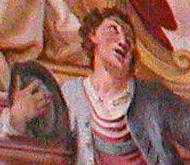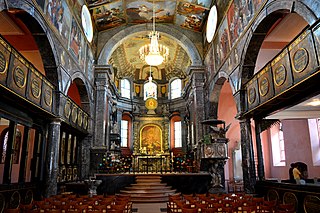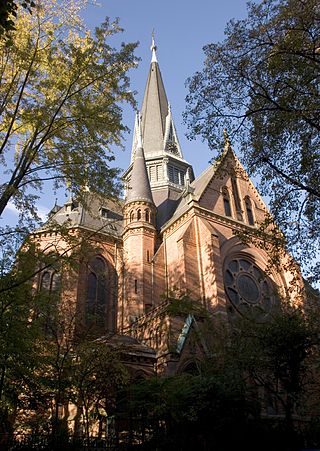
Wiesbaden is a city in central western Germany and the capital of the state of Hesse. As of June 2020, it had 290,955 inhabitants, plus approximately 21,000 United States citizens. The Wiesbaden urban area is home to approximately 560,000 people. Wiesbaden is the second-largest city in Hesse after Frankfurt am Main.

Limburg Cathedral (German: Limburger Dom, also known as Georgsdom after its dedication to Saint George, is located above the old town of Limburg in Hesse, Germany. It is the cathedral of the Catholic Diocese of Limburg. Its high location on a rock above the river Lahn provides its visibility from far away. It is the result of an Early Gothic modernization of an originally Early Romanesque building and therefore shows a Romanesque-Gothic transitional style.

Frauenstein is the westernmost borough of the city of Wiesbaden, located in the Rhine Main Area near Frankfurt and capital of the federal state of Hesse, Germany. The borough has a population of approximately 2,400. The formerly independent village was incorporated into Wiesbaden in 1928.

Matthäus Günther was an important German painter and artist of the Baroque and Rococo era.

St. Catherine's Church is the largest Protestant church in Frankfurt am Main, Germany. It is a parish church in the old city centre near one of the most famous city squares, the Hauptwache. The church is dedicated to the martyred early Christian saint Catherine of Alexandria.

The Mannheim Jesuit Church is a Catholic church of historic and artistic importance in Mannheim, Germany. Church construction was begun in 1733 and completed in 1760. It was consecrated to St. Ignatius of Loyola and St. Francis Xavier. During the Second World War, the church suffered severe damage from air attacks; after the war it was rebuilt in its historical style using original parts.

Schierstein is a southwestern borough of Wiesbaden, capital of state of Hesse, Germany. First mentioned in historical records in 860, Schierstein was incorporated into Wiesbaden in 1926. Today the borough has about 10,000 residents. Situated on the Rhine River, Schierstein is known as the "Gateway to the Rheingau."
Andreas Karasiak is a German classical tenor in opera and concert.

The Unionskirche is the active Protestant parish church of Idstein, a town in the Rheingau-Taunus district in the German state of Hesse. Idstein was a residence of the counts of Nassau. The church building in the center of the historic Altstadt dates back to the 14th century when it was built as a collegiate church. It became Lutheran during the Reformation. Its interior was adapted in the 17th century to become a Lutheran Predigt- und Hofkirche. The most prominent decoration in the church is the series of 38 paintings by the Flemish painter Michael Angelo Immenraedt, an exponent of Flemish Baroque painting, and others. They follow a program of biblical scenes.

Rheingauer Dom is the colloquial name for the Catholic parish church in Geisenheim, Germany. Officially Pfarrkirche Heilig Kreuz, the large church in the Rheingau region is called Dom although it was never a bishop's seat. The present building was begun in the 16th century, but major features such as an expansion of the nave from three to five vaults, the towers, the organ and several altars were added in the 19th century. The parish is part of the Diocese of Limburg.

Marktkirche is the main Protestant church in Wiesbaden, the state capital of Hesse, Germany. The neo-Gothic church on the central Schlossplatz was designed by Carl Boos and built between 1853 and 1862. At the time it was the largest brick building of the Duchy of Nassau. It is also called Nassauer Landesdom.

Schiersteiner Kantorei is a German concert choir, founded in 1962 at the Christophoruskirche in Wiesbaden-Schierstein. The choir performs regularly in the Marktkirche, Wiesbaden, and in Eberbach Abbey. It is known internationally through its tours and recordings. The choir was awarded the Culture Prize of the City of Wiesbaden in 1990.

Martin Lutz is a German musicologist, conductor and harpsichordist. He was the musical director of the concert choir Schiersteiner Kantorei in Wiesbaden from 1972 to 2017, and founded the biennial festival Wiesbadener Bachwochen in 1975.

St. Lamberti is a parish and church in Hildesheim, Germany, the parish of the town's Neustadt. It is named after Lambert of Maastricht, the patron saint of Hildesheim. The church is a late Gothic building, the only hall church of the town. Since the Reformation, it has been a Lutheran parish church. It is situated in the Goschenstraße, on the Neustädter Markt.

The Protestant Amandus Church in Freiberg am Neckar, Germany, is a late Gothic fortified former village church. Apart from the collegiate church in Bad Urach it is the only church of that name in Baden-Württemberg. Situated on a hill above the old village centre, it is notable for a diversity of architectural styles and for its paintings and organ.

Rheingauer Kantorei, now Neue Rheingauer Kantorei, is a mixed choir of the Rheingau region in Germany, performing mostly sacred music in services and concerts.

St. Peter's Church is located beneath Deutschhaus Mainz in the northwest of the historical center of Mainz, Germany. It is the one of the most important rococo buildings in Mainz. Originally it was a collegiate church monastery of ″St. Peter before the walls″, which had existed since the 10th century and is dedicated to the apostle Peter as patron. Today it serves as a parish church for the parish of St. Peter / St. Emmeran.

The Bergkirche is one of four main Protestant churches in Wiesbaden, the capital of Hesse, Germany. It was completed in 1879 in Gothic Revival based on a design by Johannes Otzen. The church is focused on having the altar and pulpit close to the congregation, following Luther's concept of a universal priesthood. It also serves as a concert venue for church music.

Wiesbadener Bachwochen is a biennial festival of music around Johann Sebastian Bach in Wiesbaden, the state capital of Hesse, Germany. It was initiated and has been run by Martin Lutz. The city awards the Bachpreis der Landeshauptstadt Wiesbaden to an organist who wins the festival's international competition.

St. Gallus is a Catholic church and parish in Flörsheim, Hesse, Germany, dedicated to Saint Gall. It was completed in 1766 in Rococo style. Featuring a historic organ from 1709, it is a concert venue of the Gallus-Konzerte series of mostly sacred music concerts.


















